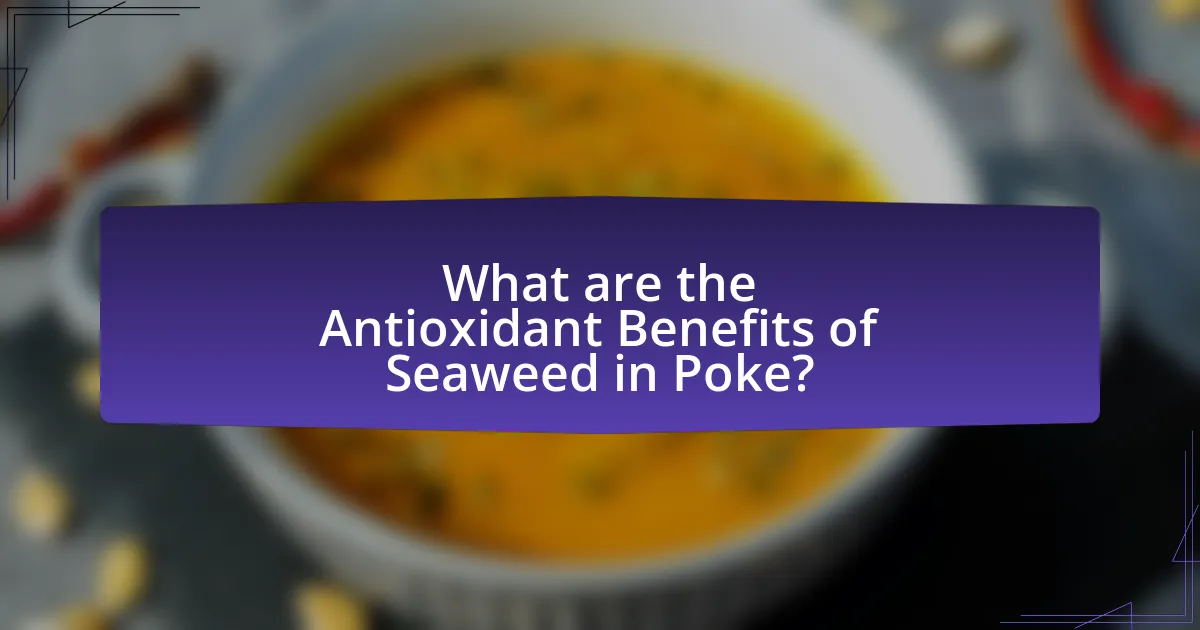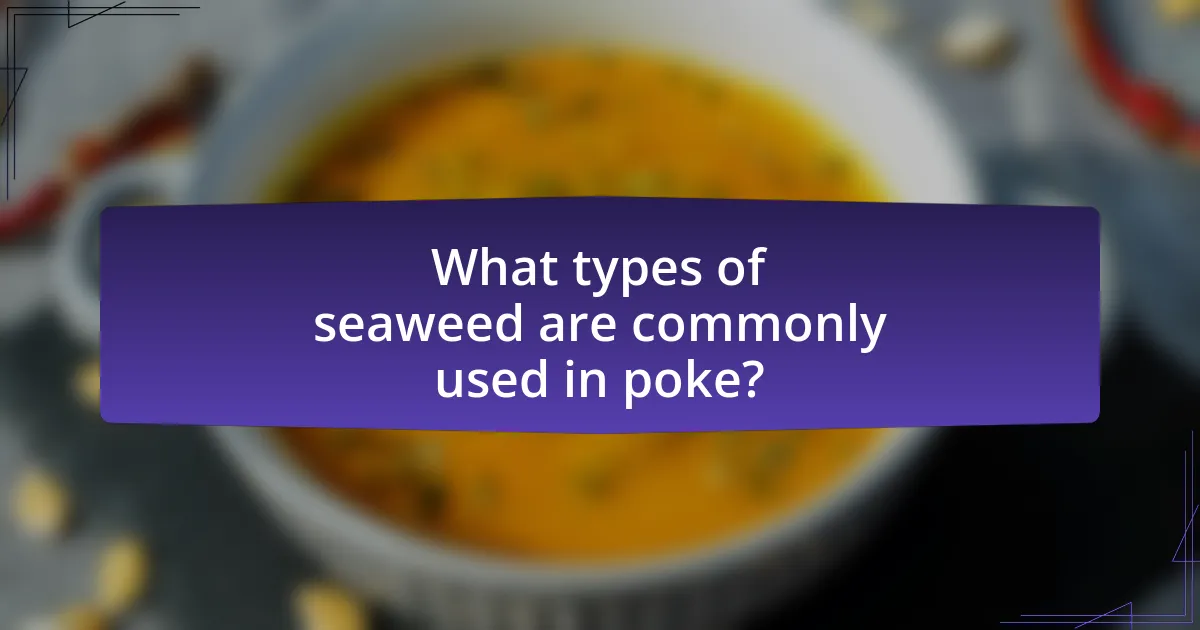Seaweed is a key ingredient in poke, offering significant antioxidant benefits due to its rich content of vitamins, minerals, and bioactive compounds. This article explores how antioxidants found in seaweed, such as vitamins C and E, polyphenols, and carotenoids, help neutralize free radicals and reduce oxidative stress, potentially lowering the risk of chronic diseases. It also examines the specific types of seaweed commonly used in poke, their varying antioxidant levels, and the nutritional advantages they provide. Additionally, the article discusses best practices for selecting, storing, and preparing seaweed to maximize its health benefits, along with creative ways to incorporate it into poke dishes.

What are the Antioxidant Benefits of Seaweed in Poke?
Seaweed in poke provides significant antioxidant benefits due to its high content of vitamins, minerals, and bioactive compounds. Specifically, seaweed contains antioxidants such as vitamins C and E, as well as polyphenols and carotenoids, which help neutralize free radicals in the body. Research indicates that these antioxidants can reduce oxidative stress, potentially lowering the risk of chronic diseases such as heart disease and cancer. For instance, a study published in the Journal of Applied Phycology found that certain seaweed species exhibit strong antioxidant activity, highlighting their role in promoting health when included in dishes like poke.
How do antioxidants in seaweed contribute to health?
Antioxidants in seaweed contribute to health by neutralizing free radicals, which can cause oxidative stress and lead to chronic diseases. Seaweed contains various antioxidants, including vitamins A, C, and E, as well as polyphenols and carotenoids, which have been shown to reduce inflammation and support immune function. Research indicates that the consumption of seaweed can lower the risk of conditions such as heart disease and cancer due to its ability to combat oxidative damage. For instance, a study published in the Journal of Agricultural and Food Chemistry found that specific seaweed varieties exhibit significant antioxidant activity, highlighting their potential health benefits.
What specific antioxidants are found in seaweed?
Seaweed contains specific antioxidants such as fucoxanthin, carotenoids, and polyphenols. Fucoxanthin, a unique pigment found in brown seaweed, has been shown to exhibit anti-inflammatory and anti-cancer properties. Carotenoids, which include compounds like beta-carotene, are known for their ability to neutralize free radicals and support overall health. Polyphenols, abundant in various seaweed species, contribute to antioxidant activity and have been linked to reduced oxidative stress. These antioxidants collectively enhance the nutritional profile of seaweed, making it a valuable ingredient in dishes like poke.
How do these antioxidants combat oxidative stress?
Antioxidants in seaweed combat oxidative stress by neutralizing free radicals, which are unstable molecules that can damage cells. These antioxidants, such as vitamins C and E, polyphenols, and carotenoids, donate electrons to free radicals, stabilizing them and preventing cellular damage. Research indicates that seaweed contains high levels of these compounds; for instance, a study published in the Journal of Applied Phycology found that certain seaweed species exhibit significant antioxidant activity, effectively reducing oxidative stress markers in biological systems.
Why is seaweed a popular ingredient in poke?
Seaweed is a popular ingredient in poke due to its rich nutritional profile and unique flavor. It provides essential vitamins and minerals, including iodine, calcium, and vitamins A, C, and E, which contribute to overall health. Additionally, seaweed contains antioxidants that help combat oxidative stress, making it a beneficial addition to poke bowls. Its umami flavor enhances the dish, complementing the freshness of the fish and other ingredients, thus elevating the overall taste experience.
What nutritional benefits does seaweed provide in poke dishes?
Seaweed provides numerous nutritional benefits in poke dishes, including high levels of vitamins, minerals, and antioxidants. Specifically, seaweed is rich in iodine, which supports thyroid function, and contains vitamins A, C, E, and K, contributing to overall health. Additionally, seaweed is a source of dietary fiber, promoting digestive health, and contains antioxidants like carotenoids and flavonoids that help combat oxidative stress. Studies have shown that the consumption of seaweed can enhance nutrient intake and provide protective health benefits, making it a valuable ingredient in poke dishes.
How does the flavor of seaweed enhance poke?
The flavor of seaweed enhances poke by adding a unique umami taste that complements the freshness of the fish. Seaweed contains natural glutamates, which intensify the overall flavor profile of poke, making it more savory and satisfying. Additionally, the briny notes of seaweed provide a contrast to the sweetness of the fish and the acidity of any accompanying sauces, creating a balanced dish. This flavor enhancement is supported by the culinary principle that umami flavors can elevate the perception of freshness and quality in seafood dishes.

What types of seaweed are commonly used in poke?
Commonly used types of seaweed in poke include wakame, nori, and dulse. Wakame is often added for its tender texture and nutritional benefits, while nori, typically used in sushi, provides a distinct flavor and is rich in vitamins. Dulse is valued for its unique taste and high antioxidant content, contributing to the overall health benefits of poke dishes.
How do different types of seaweed vary in antioxidant content?
Different types of seaweed exhibit significant variation in antioxidant content, with species such as brown seaweeds (e.g., kombu and wakame) generally showing higher levels of antioxidants compared to red and green seaweeds. For instance, studies have demonstrated that brown seaweeds contain polyphenols and carotenoids, which contribute to their antioxidant properties, while red seaweeds like nori have lower concentrations of these compounds. Research published in the Journal of Applied Phycology indicates that the antioxidant activity of seaweeds can vary widely, with some brown seaweeds exhibiting up to 10 times more antioxidant capacity than certain green seaweeds. This variation is influenced by factors such as species, environmental conditions, and harvesting methods.
What are the most popular seaweed varieties used in poke?
The most popular seaweed varieties used in poke are nori, wakame, and dulse. Nori, commonly used for sushi, adds a savory flavor and is rich in vitamins and minerals. Wakame, often found in miso soup, provides a slightly sweet taste and is known for its high antioxidant content. Dulse, a red seaweed, offers a unique flavor and is also recognized for its nutritional benefits, including protein and fiber. These seaweeds not only enhance the taste of poke but also contribute to its health benefits, particularly through their antioxidant properties.
How can the preparation of seaweed affect its antioxidant levels?
The preparation of seaweed can significantly affect its antioxidant levels by altering the bioavailability and stability of these compounds. Cooking methods such as boiling or steaming can lead to the degradation of certain antioxidants, while drying processes may concentrate them. For instance, a study published in the Journal of Applied Phycology found that drying seaweed at low temperatures preserved higher levels of phenolic compounds compared to high-temperature methods, which can cause loss of these beneficial antioxidants. Additionally, soaking seaweed before consumption can enhance the extraction of antioxidants, making them more accessible for absorption in the body.
What role does seaweed play in traditional poke recipes?
Seaweed serves as a key ingredient in traditional poke recipes, providing flavor, texture, and nutritional benefits. In Hawaiian cuisine, seaweed, particularly varieties like wakame and limu, enhances the dish’s umami profile while contributing essential minerals and antioxidants. Research indicates that seaweed is rich in vitamins A, C, and E, which are known for their antioxidant properties, thereby promoting health benefits when included in poke.
How has the use of seaweed in poke evolved over time?
The use of seaweed in poke has evolved from traditional Hawaiian practices to contemporary culinary trends that emphasize health benefits. Initially, seaweed was primarily used in poke for its flavor and texture, with varieties like limu kohu being common. Over time, the incorporation of seaweed has expanded to include a variety of types, such as nori and wakame, reflecting a growing awareness of its nutritional value, particularly its antioxidant properties. Research indicates that seaweed is rich in vitamins, minerals, and antioxidants, which has led to its increased popularity in poke bowls as a health-conscious ingredient. This shift aligns with broader trends in the food industry that prioritize functional foods, showcasing seaweed not just as a traditional component but as a superfood enhancing the overall health profile of poke dishes.
What cultural significance does seaweed hold in poke cuisine?
Seaweed holds significant cultural importance in poke cuisine as it is a traditional ingredient that reflects the culinary heritage of Hawaii. In Hawaiian culture, seaweed, particularly varieties like nori and limu, is not only a source of nutrition but also a symbol of the connection to the ocean and the land. Historically, seaweed has been used in various Hawaiian dishes, providing essential vitamins and minerals, and enhancing the flavor profile of poke. Its incorporation into poke showcases the blend of indigenous practices with modern culinary trends, emphasizing sustainability and respect for marine resources.

How can consumers maximize the antioxidant benefits of seaweed in poke?
Consumers can maximize the antioxidant benefits of seaweed in poke by selecting a variety of seaweed types, such as nori, wakame, and dulse, which are rich in antioxidants like vitamins A, C, and E, as well as polyphenols. Incorporating these seaweeds in their poke bowls not only enhances flavor but also increases the overall antioxidant content. Research indicates that different seaweed species contain varying levels of antioxidants; for instance, a study published in the Journal of Applied Phycology found that certain red and brown seaweeds exhibit higher antioxidant activity compared to others. Additionally, consuming seaweed raw or lightly cooked preserves its antioxidant properties, as excessive heat can degrade these beneficial compounds.
What are the best practices for selecting seaweed for poke?
The best practices for selecting seaweed for poke include choosing fresh, high-quality varieties such as wakame or nori, ensuring they are free from contaminants, and checking for vibrant color and a pleasant aroma. Fresh seaweed retains its nutritional benefits, including antioxidants, which are essential for enhancing the poke’s health properties. Additionally, sourcing seaweed from reputable suppliers who adhere to safety standards can minimize the risk of pollutants, as studies indicate that seaweed can absorb heavy metals from the environment.
How should seaweed be stored to preserve its antioxidants?
Seaweed should be stored in a cool, dry place, preferably in an airtight container to preserve its antioxidants. This storage method minimizes exposure to moisture and light, both of which can degrade the antioxidant compounds in seaweed. Research indicates that antioxidants in seaweed, such as polyphenols and carotenoids, are sensitive to environmental factors; thus, proper storage is crucial for maintaining their efficacy.
What cooking methods retain the most antioxidants in seaweed?
Steaming and microwaving are the cooking methods that retain the most antioxidants in seaweed. Research indicates that these methods minimize exposure to heat and water, which can degrade antioxidant compounds. A study published in the Journal of Food Science found that steaming preserved up to 90% of the antioxidants in seaweed compared to boiling, which resulted in significant losses due to leaching. Similarly, microwaving has been shown to maintain high levels of antioxidants by reducing cooking time and limiting nutrient loss.
What are some tips for incorporating seaweed into poke at home?
To incorporate seaweed into poke at home, consider using dried seaweed varieties like nori or wakame, which can enhance flavor and texture. Dried nori can be cut into strips or squares and added directly to poke bowls, while rehydrated wakame can be mixed with other ingredients for a nutrient boost. Seaweed is rich in antioxidants, vitamins, and minerals, making it a healthy addition to poke. For example, a study published in the Journal of Applied Phycology highlights that seaweed contains high levels of antioxidants, which can contribute to overall health when included in meals.
How can you create a balanced poke bowl with seaweed?
To create a balanced poke bowl with seaweed, include a base of cooked brown rice or quinoa, which provides complex carbohydrates and fiber. Add a variety of fresh vegetables such as cucumbers, carrots, and radishes for vitamins and minerals. Incorporate a protein source like marinated raw fish, tofu, or edamame to ensure adequate protein intake. Seaweed, such as nori or wakame, can be added for its antioxidant properties and essential nutrients like iodine. Finally, drizzle a light sauce made from soy sauce, sesame oil, and lime juice to enhance flavor without overwhelming the dish. This combination ensures a well-rounded meal that is nutritious and satisfying.
What are some creative recipes that highlight seaweed in poke?
Creative recipes that highlight seaweed in poke include a seaweed salad poke bowl, where wakame seaweed is mixed with diced avocado, cucumber, and sesame oil, providing a rich source of antioxidants. Another option is a spicy seaweed poke, incorporating nori strips with marinated tuna, sriracha, and lime juice, enhancing both flavor and nutritional value. Additionally, a seaweed and mango poke features kombu and fresh mango cubes, offering a unique sweet and savory combination while delivering essential nutrients. These recipes utilize various types of seaweed, known for their high antioxidant content, such as fucoxanthin, which has been shown to have health benefits.



